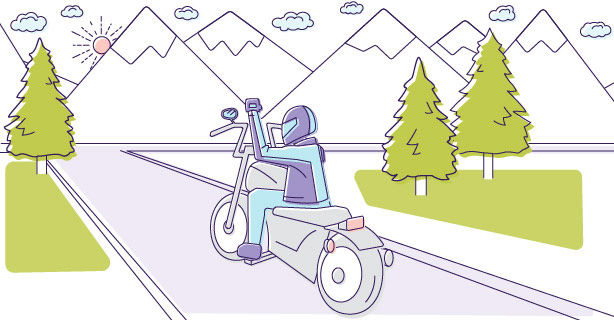10 hand signals every motorcycle rider should know
0 min. read
Since motorcycles don't have as many standard built-in signals as other vehicles, it's often up to you to communicate through hand signals to tell other drivers—and the rest of your riding group—what your next move is. Here are 10 important hand signals to recognize, practice, and add to your riding repertoire.
1. Turn left or right
Hold your left arm out straight at your side to indicate you're about to turn left. To signal a right turn, hold your left arm out at your side and bend up at the elbow to make a right angle, and make a fist.

2. Stop
Even though your motorcycle likely has brake lights, it's still courteous to indicate when you're about to come to a stop. Hold your left arm out to your side and turn it down with your palm facing backward.

3. Ride single-file or side-by-side
If you want to let your fellow riders know you should all be riding single-file in your lane, hold your left arm up at your side in a 90-degree angle with your index finger in the air. Similarly, if you want your group to ride side-by-side, hold up your left arm with two fingers in the air.

4. Slow down
Put your left arm out to your side with your palm facing down, then move your arm down. This should let everyone in your group know to reduce their speed.

5. Speed up
Put your left arm out to your side with your palm facing up, then raise your arm to direct the rest of your group to increase their speed. Just make sure you adhere to the speed limit.

6. Pull over
If you need to quickly notify your group that you're about to pull off, raise your left arm out and above your helmet. Point your index finger toward the roadside shoulder.

7. Stop for gas
Extend your left arm to the side and point at your fuel tank. This will give the other riders a heads up that you plan to pull over for a fuel stop at the next opportunity.

8. Stop for food or refreshment
Need to stop for a quick drink or a bite to eat? Lift your left fist to the side of your head with your thumb pointing to your mouth. This will let others know it's about time to stop for a different type of refueling.

9. Stop for comfort
Taking frequent stretch breaks can help you stay comfortable and focused on long rides. To signal your intent to pull over to stretch, extend your left forearm out to your side with your fist closed. Move your forearm up and down in small movements.

10. Watch for hazard ahead
If you see a hazard in the roadway like debris or roadkill, be sure to warn your fellow riders. If the hazard is on your left, then point toward the road with your left hand. If the hazard is coming up on your right, then point with your right foot.

Get your motorcycle hand signal download
If you’re looking for a downloadable quick reference to our 10 hand signals, you’re in luck. For those of you in Texas, here’s your hand signal guide. Enjoy your ride!
Related links
Now that you know these useful motorcycle hand signals, take a motorcycle safety course to learn additional strategies to help keep yourself and others safe on the road.
As much as you’d like to, you can’t keep your eyes on your bike all the time. That’s why it’s crucial to take steps to help protect your motorcycle from theft, whether you’re at home or out on the road.
The general information in this blog is for informational or entertainment purposes only. View our blog disclaimer.
*Data accuracy is subject to this article's publication date.







